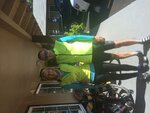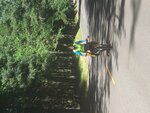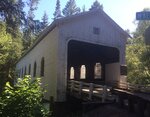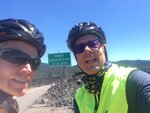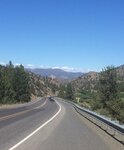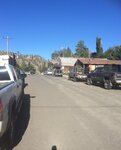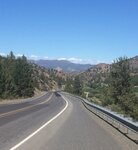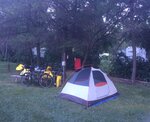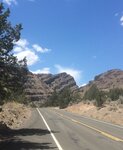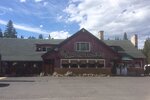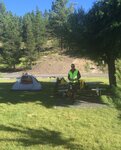Claire and Primo
Member
Let me introduce myself. My name is Claire. My husband and I are retirees in our late 50's and early 60's and we are not cyclists. We are, however, active and adventurous. After walking 500 mikes on the Camino de Santiago in 2015, we decided to make 2016 the year of the bicycle trek.
Because we are not cyclists, because my husband is generally stronger and faster than I, and because I hate to fight the wind and hills, we decided to level the playing field by cycling with pedal assist bikes. Quite frankly I would not have undertaken this trek without pedal assist. We researched the different pedal assist bikes on the market, hoping to find one that was lighter in weight and with the coveted Bosch system. We also wanted a bike that was tough and would handle not only the road but also be versatile for trail riding. We settled on the Felt Nine E 20 hard tail mountain bike which weighs in at 38 lbs and has a battery range of 20-60 miles.
We equipped our bikes with a rear rack and installed fenders front and rear, attaching a blinkee to the rack. We also installed Ergon handlebar grips, a Mirrcycle rear view mirror, clip pedals, and replaced the stock saddle with Brooks B17 saddles. We purchased two large ortlieb panniers, one ortlieb medium size rack pack, a small bar bag, and a Rixen and Kaul klick fix handlebar bag for each bike. The Schwalbe stock tires were traded out for Schwalbe Rapid Rob tires in order to accommodate the fenders. And most importantly, we purchased an extra Bosch battery to ensure we had power on those long deserted stretches. Note that my bike -a medium frame, did not have any braze-ons for a water bottle, and the braze-ons on my husbands large frame bike did not fit his bottle. So we each put two water bottles in our handlebar bags.
And so we left July 14 from Eugene Oregon riding the Transamerica. After nearly 1000 miles we can report that the bikes have performed wonderfully. We were originally concerned about the stability of the bikes with all of the weight in the back, but we try to load the rack as forward as possible and all has been fine. We have had no issue with the components of the bikes.
My husband did experience 1 flat on the front tire; I have not had one. After 1000 miles the rear tire knobs are almost worn smooth and we have experienced that the Rapid Robs roll very slowly. So we are replacing them with Continental Travel Contact tires; I will get back to you on how they perform.
As far as battery performance is concerned, there has not been a mountain pass or a headwind that I cannot conquer. Of course the battery life is affected by these things. We are both carrying about 40 lbs of belongings on the rear, and with that weight we are able to ride about 40-45 miles on level terrain and about 30 miles when on rolling hills (note we are not heavy people: I am 130 lbs and my husband 160 lbs). Mountain passes exhaust the battery after about 20 miles.
When we first began I had "battery anxiety"; I was fixated on whether we would be able to recharge. After all these miles my anxiety is gone; there are countless placed to recharge. City parks, city libraries, restaurants, etc ( we ask permission and have never been denied). You will find electrical outlets in all kinds of places -just take advantage of them and be smart to recharge whenever you can. It takes about 2 1/2 hours to completely recharge.
And finally I was a bit worried about how hard core cyclists would react to us. In this regard we have not seen any other touring cyclists using peddle assist bikes. So far no one has said anything negative to our faces, and more often than not we are asked a lot of questions. However, if given a hard time, I already have my response: There are many ways to ride across the country; there are the purists who ride touring bikes, cook their own meals, and camp. Then there are those who ride with some amount of support, whether all of their belongings are carried for them or support only in the event of mechanical issues. I am a version of these cyclists-I carry my own things, camp when possible, and hand wash my own clothes. I do not receive vehicle support but rather battery support. I admire the purists but realize that I am not one of them.
And that is how I roll.
Claire
Because we are not cyclists, because my husband is generally stronger and faster than I, and because I hate to fight the wind and hills, we decided to level the playing field by cycling with pedal assist bikes. Quite frankly I would not have undertaken this trek without pedal assist. We researched the different pedal assist bikes on the market, hoping to find one that was lighter in weight and with the coveted Bosch system. We also wanted a bike that was tough and would handle not only the road but also be versatile for trail riding. We settled on the Felt Nine E 20 hard tail mountain bike which weighs in at 38 lbs and has a battery range of 20-60 miles.
We equipped our bikes with a rear rack and installed fenders front and rear, attaching a blinkee to the rack. We also installed Ergon handlebar grips, a Mirrcycle rear view mirror, clip pedals, and replaced the stock saddle with Brooks B17 saddles. We purchased two large ortlieb panniers, one ortlieb medium size rack pack, a small bar bag, and a Rixen and Kaul klick fix handlebar bag for each bike. The Schwalbe stock tires were traded out for Schwalbe Rapid Rob tires in order to accommodate the fenders. And most importantly, we purchased an extra Bosch battery to ensure we had power on those long deserted stretches. Note that my bike -a medium frame, did not have any braze-ons for a water bottle, and the braze-ons on my husbands large frame bike did not fit his bottle. So we each put two water bottles in our handlebar bags.
And so we left July 14 from Eugene Oregon riding the Transamerica. After nearly 1000 miles we can report that the bikes have performed wonderfully. We were originally concerned about the stability of the bikes with all of the weight in the back, but we try to load the rack as forward as possible and all has been fine. We have had no issue with the components of the bikes.
My husband did experience 1 flat on the front tire; I have not had one. After 1000 miles the rear tire knobs are almost worn smooth and we have experienced that the Rapid Robs roll very slowly. So we are replacing them with Continental Travel Contact tires; I will get back to you on how they perform.
As far as battery performance is concerned, there has not been a mountain pass or a headwind that I cannot conquer. Of course the battery life is affected by these things. We are both carrying about 40 lbs of belongings on the rear, and with that weight we are able to ride about 40-45 miles on level terrain and about 30 miles when on rolling hills (note we are not heavy people: I am 130 lbs and my husband 160 lbs). Mountain passes exhaust the battery after about 20 miles.
When we first began I had "battery anxiety"; I was fixated on whether we would be able to recharge. After all these miles my anxiety is gone; there are countless placed to recharge. City parks, city libraries, restaurants, etc ( we ask permission and have never been denied). You will find electrical outlets in all kinds of places -just take advantage of them and be smart to recharge whenever you can. It takes about 2 1/2 hours to completely recharge.
And finally I was a bit worried about how hard core cyclists would react to us. In this regard we have not seen any other touring cyclists using peddle assist bikes. So far no one has said anything negative to our faces, and more often than not we are asked a lot of questions. However, if given a hard time, I already have my response: There are many ways to ride across the country; there are the purists who ride touring bikes, cook their own meals, and camp. Then there are those who ride with some amount of support, whether all of their belongings are carried for them or support only in the event of mechanical issues. I am a version of these cyclists-I carry my own things, camp when possible, and hand wash my own clothes. I do not receive vehicle support but rather battery support. I admire the purists but realize that I am not one of them.
And that is how I roll.
Claire
